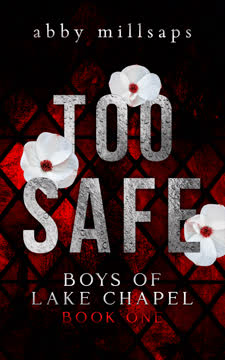Plot Summary
Brotherhood's Unraveling Begins
At Hawthorne Hall, a prestigious fraternity, the arrival of Elliot, a female initiate, disrupts the established order. The brotherhood, led by Kingston, Archer, and Cannon, is already strained by secrets and past traumas. Elliot's presence is both a challenge and a balm, as she navigates the house's toxic traditions and the boys' complicated feelings. The narrative quickly reveals that beneath the surface camaraderie, old wounds and rivalries fester, and the brotherhood's unity is more fragile than it appears. Elliot's resilience and vulnerability draw the three leaders to her, but also expose their own weaknesses. The story's emotional tension is set: trust, loyalty, and the cost of belonging will be tested as the group faces threats from within and without.
Elliot's Disappearance
When Elliot leaves campus early, the brotherhood's leaders sense something is wrong. Their frantic search reveals she's been abducted by Nick, her abusive ex-boyfriend. The boys' guilt and fear are palpable as they realize their failure to protect her. The house's toxic dynamics are laid bare: Alec, a resentful brother, saw Elliot's abduction and did nothing. The group's unity is tested as blame and regret swirl. The emotional stakes rise as Kingston, Archer, and Cannon confront their own past traumas—Kingston's loss of his sister, Cannon's epilepsy and self-doubt, Archer's need for control—and channel their pain into a desperate rescue mission. The brotherhood's code of protection is no longer just tradition; it's a matter of life and death.
The Games and the Past
The fraternity's brutal initiation games serve as both a rite of passage and a crucible for trauma. Elliot's participation is fraught with danger, not just from the physical challenges but from the psychological scars she carries from Nick's abuse. The games force the brothers to confront their own histories: Kingston's guilt over his sister's suicide, Cannon's struggle with his medical condition, and Archer's hidden pain. The games become a metaphor for survival and resilience, as Elliot's determination inspires the others to face their demons. The narrative weaves past and present, showing how the legacy of violence and secrecy shapes the brotherhood's present crisis.
Nick's Return
Nick's reappearance is a catalyst for chaos. He kidnaps Elliot, subjecting her to physical and psychological torment that echoes her past trauma. The narrative delves into the cycle of abuse, showing how Nick's manipulation and violence have left lasting scars on Elliot's psyche. The brothers' rescue mission is as much about saving themselves as it is about saving her; their rage and guilt drive them to brutal retribution. The emotional impact is raw: Elliot's pain is mirrored in the boys' own suffering, and the lines between victim and protector blur. The rescue is not just a physical act but a reckoning with the past.
Rescue and Revelations
The brothers storm the motel where Nick holds Elliot, unleashing their fury on her abuser. The aftermath is messy—physically, emotionally, and morally. Elliot is traumatized, her self-harm scars exposed, and the boys are forced to confront the limits of their protection. The rescue is not a clean victory; it leaves everyone shaken and vulnerable. In the aftermath, secrets spill out: Elliot's history of self-harm, the boys' own traumas, and the realization that the house's toxic culture enabled Nick's violence. The group's bonds are tested as they struggle to care for Elliot and for each other, learning that healing requires honesty and vulnerability.
Scars and Secrets
Elliot's physical and emotional scars become a focal point for the group's healing—and its fractures. Her self-harm is both a symptom and a symbol of the house's deeper wounds. The boys' attempts to care for her are complicated by their own guilt and shame. Archer, in particular, takes on the role of caretaker, but his need for control is challenged by Elliot's independence. The group's secrets—about the past, about Will's disappearance, about their own desires—bubble to the surface, threatening to tear them apart. The narrative explores the tension between protection and autonomy, and the difficulty of trusting others with one's pain.
Healing and Desire
In the wake of trauma, the group turns to each other for comfort and connection. Physical intimacy becomes a means of healing, as Elliot and the boys explore their desires and vulnerabilities. The narrative does not shy away from the complexities of consent, shame, and longing. The group's unconventional relationships—romantic, sexual, and platonic—are a source of both solace and tension. The emotional arc is one of tentative hope: through touch, honesty, and mutual care, the group begins to rebuild trust and reclaim their bodies from the violence of the past. Healing is messy, nonlinear, and deeply human.
Brotherhood Fractures
The house's fractures deepen as secrets come to light. The discovery of a hidden phone—belonging to Will, the missing initiate—raises new questions about the brotherhood's past. Elliot's investigation, driven by her connection to Will, exposes the house's history of hazing, abuse, and cover-ups. The boys' loyalty to each other is tested as suspicion and paranoia take hold. The narrative explores the corrosive effects of secrecy and the difficulty of breaking cycles of violence. The group must decide whether to protect the brotherhood's legacy or to seek justice for the wrongs of the past.
The Hidden Phone
The discovery of Will's phone in Kingston's room is a turning point. Elliot's secret investigation is revealed, and the group is rocked by feelings of betrayal and mistrust. The phone becomes a symbol of the house's buried secrets and the cost of silence. The group's emotional arc is one of rupture and repair: anger, hurt, and guilt give way to difficult conversations and, ultimately, forgiveness. The narrative underscores the importance of truth-telling, even when it is painful, and the possibility of redemption through vulnerability and accountability.
Truths and Betrayals
As the group confronts the truth about Will's disappearance, old alliances are tested and new ones forged. Elliot's revelation that she is Will's cousin and has been investigating his fate all along is a shock to the boys, who feel betrayed by her secrecy. The emotional fallout is intense: trust is shattered, and the group must reckon with the consequences of their actions and inactions. The narrative explores the complexity of forgiveness and the necessity of confronting uncomfortable truths. The group's survival depends on their willingness to be honest—with themselves and with each other.
The Fourth Game
The fourth and final initiation game is both a physical and emotional crucible. The obstacle course is a test of endurance, but also a metaphor for the group's journey through trauma and healing. Elliot's determination and resilience inspire the others, and the group's bonds are strengthened through shared struggle. The narrative uses the game to explore themes of perseverance, solidarity, and the possibility of transformation. The group's victory is not just in completing the course, but in choosing to stand together against the house's toxic legacy.
The Alumni Arrive
The arrival of Kingston's father, a powerful alumni figure, brings the house's secrets to the brink of exposure. The threat of expulsion and scandal looms, and the group must navigate the politics of power and tradition. The alumni's presence is both a reminder of the house's history and a catalyst for change. The group's loyalty to each other is tested as they face external pressure and internal doubts. The narrative explores the tension between preserving tradition and forging a new path, and the courage required to challenge authority.
The Cellar's Secrets
The story's climax unfolds in the house's cellar, where the truth about Will's disappearance and the house's darkest secrets are finally revealed. Elliot and Dane are kidnapped and held captive by Zeke, a brother manipulated by Nick's blackmail. The confrontation exposes the web of lies, abuse, and complicity that has haunted the house. The group's rescue of Elliot and Dane is a moment of catharsis and reckoning. The narrative does not shy away from the cost of violence, but also offers the possibility of justice and closure.
The Final Confrontation
The final confrontation is brutal and cathartic. Zeke's confession, Nick's death, and the arrival of the police bring the house's cycle of violence to an end. The group's unity is tested one last time as they fight to protect each other and to ensure that the truth is known. The emotional arc is one of release and relief: the group has survived, but not without scars. The narrative acknowledges the pain of loss and the difficulty of moving forward, but also the strength that comes from solidarity and love.
Aftermath and Healing
In the aftermath, the group grapples with grief, guilt, and the challenge of rebuilding. The house is forever changed: brothers expelled, secrets exposed, and the legacy of violence confronted. Elliot and the boys find solace in each other, forging a new kind of family from the ruins. The narrative explores the ongoing process of healing, the importance of community, and the possibility of hope. The group's unconventional love is both a source of strength and a testament to their resilience.
Love in the Ruins
The story ends on a note of hard-won hope. Elliot and the boys, scarred but surviving, choose each other in the face of loss and uncertainty. Their love is messy, unconventional, and deeply human—a testament to the power of vulnerability and connection. The house's legacy is transformed, not by erasing the past, but by choosing to build something new. The narrative affirms that healing is possible, that love can endure even in the ruins, and that the bonds forged in pain can become a source of strength and joy.
Characters
Elliot Ashford
Elliot is the emotional and narrative heart of the story—a young woman who infiltrates Hawthorne Hall to uncover the truth about her missing cousin, Will. Her journey is one of survival, healing, and transformation. Scarred by past abuse and self-harm, Elliot's vulnerability is matched by her fierce determination. She challenges the house's toxic traditions, inspires the boys to confront their own traumas, and ultimately becomes the catalyst for the brotherhood's reckoning. Her relationships with Kingston, Archer, and Cannon are complex—romantic, sexual, and deeply supportive. Through her, the narrative explores themes of trust, autonomy, and the power of chosen family. Elliot's arc is one of reclaiming agency and forging a new path in the ruins of the past.
Kingston Hawthorne
Kingston is the head of Hawthorne Hall, burdened by the weight of tradition and personal loss. Haunted by his sister's suicide, he is driven by guilt and a fierce need to protect those he loves. His leadership is both a strength and a vulnerability; he struggles to balance control with compassion. Kingston's relationship with Elliot is transformative, forcing him to confront his own pain and to choose vulnerability over stoicism. His dynamic with Archer and Cannon is brotherly, but also charged with unspoken longing and rivalry. Kingston's arc is one of learning to trust, to let go of the past, and to build a new kind of brotherhood rooted in honesty and care.
Archer
Archer is the house's fixer and caretaker, always watching, always ready to step in. Beneath his calm exterior lies a well of pain—abuse at the hands of his stepbrother, a history of self-blame, and a desperate need for control. Archer's relationship with Elliot is intimate and healing; he is drawn to her vulnerability and strength. His dynamic with Kingston and Cannon is complex, blending friendship, rivalry, and desire. Archer's arc is one of learning to accept care as well as give it, to confront his own trauma, and to find healing in connection. His journey is a testament to the power of honesty and the courage required to break cycles of abuse.
Cannon
Cannon is the house's quiet anchor, struggling with epilepsy and a deep sense of inadequacy. His silence is both a shield and a wound; he fears being a burden and longs for acceptance. Cannon's relationship with Elliot is tender and possessive; she sees past his silence to the strength and vulnerability beneath. His bond with Kingston and Archer is brotherly, marked by loyalty and mutual care. Cannon's arc is one of learning to trust his own worth, to accept love, and to find his voice. His journey is a reminder that strength can be found in vulnerability and that healing is a collective endeavor.
Nick
Nick is the story's primary antagonist—a charming, manipulative, and violent ex-boyfriend whose return triggers the narrative's central crisis. He is both a product and a perpetrator of the house's toxic culture, using secrets and violence to maintain control. Nick's abuse of Elliot is depicted with unflinching honesty, and his eventual downfall is both a moment of catharsis and a reminder of the cost of silence. Nick's character serves as a foil to the boys, highlighting the dangers of unchecked power and the necessity of accountability.
Alec
Alec is a junior brother whose resentment and inaction play a crucial role in Elliot's abduction. His refusal to intervene or to break the house's code of silence is a microcosm of the brotherhood's larger failures. Alec's character is a study in complicity—the harm done not just by active malice, but by passive indifference. His eventual comeuppance is a moment of reckoning for the house.
Zeke
Zeke is a quiet, seemingly innocuous brother whose true role as Nick's accomplice is revealed in the story's climax. Blackmailed by Nick over a past crime, Zeke becomes complicit in Will's death and Elliot's abduction. His character embodies the dangers of secrecy, shame, and the corrosive effects of guilt. Zeke's unraveling is both tragic and terrifying, a reminder that evil often hides in plain sight.
Dane
Dane is a brother marked by loss and secrecy. As Will's secret boyfriend, he is haunted by grief and guilt, and his attempts to protect Elliot are both misguided and deeply human. Dane's arc is one of confession and catharsis; his willingness to finally tell the truth is a turning point in the group's healing. His character explores the costs of silence and the courage required to break it.
Will
Will, though missing and presumed dead, is a constant presence in the narrative. His disappearance is the mystery that drives Elliot's investigation and the group's reckoning with the past. Will's fate is a symbol of the house's legacy of violence and secrecy, and his memory is both a source of pain and a call to justice. Through Will, the narrative explores the ripple effects of trauma and the necessity of confronting uncomfortable truths.
Jared Hawthorne
Kingston's father and a powerful alumni figure, Jared represents the weight of tradition and the dangers of unchecked authority. His arrival threatens to expose the house's secrets and to punish those who challenge the status quo. Jared's character is a study in the costs of loyalty to legacy over people, and his confrontations with Kingston are moments of generational reckoning. Through him, the narrative explores the tension between preserving tradition and forging a new path.
Plot Devices
Dual Timelines and Interwoven Trauma
The novel employs a dual timeline structure, weaving together the present-day crisis with flashbacks and revelations about the past. The initiation games serve as both plot device and metaphor, forcing characters to confront old wounds and to reenact cycles of violence and healing. The narrative's structure mirrors the characters' psychological journeys: secrets are buried and unearthed, trust is broken and rebuilt, and the past is never truly past. Foreshadowing is used to build tension—Elliot's scars, the hidden phone, the house's history of disappearances—all hint at the darkness beneath the surface. The story's emotional arc is one of rupture and repair, with each revelation bringing the group closer to both destruction and healing.
Unreliable Narration and Shifting Perspectives
The novel's use of multiple first-person perspectives allows for a rich exploration of each character's inner life. The shifting narration creates dramatic irony, as readers are privy to secrets and motivations unknown to other characters. This device heightens tension and empathy, as the group's misunderstandings and betrayals are seen from all sides. The unreliable narration also mirrors the characters' struggles with memory, trauma, and trust—what is hidden, what is revealed, and what is believed.
Symbolism of Scars, Games, and the House
Physical scars—Elliot's self-harm, Nick's violence—are symbols of deeper psychological wounds. The initiation games are both literal and metaphorical tests, forcing characters to confront their limits and to choose between survival and complicity. The house itself is a character, its rooms and secrets a map of the group's collective trauma. The hidden phone, the cellar, and the attic are all sites of revelation and reckoning. These symbols are woven throughout the narrative, reinforcing themes of pain, resilience, and the possibility of transformation.
Foreshadowing and Red Herrings
The narrative is rich with foreshadowing—Elliot's unease, the boys' secrets, the house's history—all hint at the coming crisis. Red herrings abound: suspicion falls on various brothers, and the true villain is hidden in plain sight. The use of misdirection keeps readers guessing and heightens the emotional impact of each revelation. The story's structure is a puzzle, with each piece falling into place only at the climax.
Analysis
Archer by Leila James is a dark, emotionally charged exploration of trauma, power, and the redemptive potential of chosen family. Set against the backdrop of a toxic fraternity, the novel interrogates the costs of secrecy, the dangers of tradition, and the courage required to break cycles of violence. Through its complex, deeply human characters, the story examines the ways in which pain is both inherited and inflicted, and how healing is possible only through honesty, vulnerability, and mutual care. The narrative's unconventional relationships challenge norms of gender, sexuality, and love, offering a vision of intimacy that is messy, nonlinear, and profoundly real. The novel's lessons are clear: silence enables harm, tradition must be questioned, and true strength lies in the willingness to be seen and to see others in their full, wounded humanity. In the end, Archer is a testament to the power of survival, the necessity of justice, and the enduring hope that love can flourish even in the ruins.
Last updated:
Review Summary
Archer by Leila James is the final book in the Brothers of Hawthorne Hall series, receiving mostly positive reviews. Readers praise the intense emotions, steamy scenes, and satisfying conclusion to the trilogy. The book explores Archer's backstory and ties up loose ends from previous installments. Many reviewers appreciate the character development, plot twists, and the author's ability to create a believable reverse harem romance. Some criticism mentions misplaced sex scenes and unnecessary tragic backstories. Overall, fans of the series found it a thrilling and emotional conclusion.













